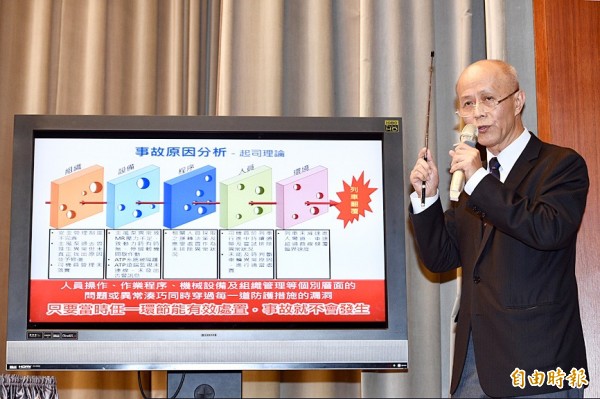《TAIPEI TIMES》 Investigation blames TRA for Puyuma derailment

Railway Bureau Director-General Allen Hu explains the results of a report on the Oct. 21 Puyuma Express derailment at the Executive Yuan in Taipei yesterday. Photo: Peter Lo, Taipei Times
By Shelley Shan / Staff reporter
The derailment of a Puyuma Express train in Hualien last month was caused by the Taiwan Railways Administration’s (TRA) failure to address a series of loopholes in its safety mechanism, an Executive Yuan investigative team concluded yesterday.
Eighteen people died and 267 were injured when Puyuma Express No. 6432 derailed outside Sinma Train Station (新馬) in Yilan County on Oct. 21.
The high number of casualties prompted the Cabinet to assemble a team to investigate the cause.
The team, led by Minister Without Portfolio Wu Tze-cheng (吳澤成), released the preliminary results of its investigation ahead of Premier William Lai’s (賴清德) briefing at the Legislative Yuan today.
The team would identify the problems facing the railway agency and propose solutions based on the facts and the cause of the accident, Wu said at a presentation to share the team’s findings.
Railway Bureau Director-General Allen Hu (胡湘麟) said that members of the team reviewed all the evidence, including footage from surveillance cameras, data recorded on the train control and management system, the automatic train protection (ATP) system’s data log, and communication logs between the conductor and the train dispatcher.
The team found that two of four air compressors on the train had been operating abnormally before it departed from Shulin Station (樹林), Hu said.
The air tanks had low pressure as the train left Cidu Station (七堵), which led to an unstable power supply and caused it to stop intermittently 10 times, he said.
To resolve the problem with the air compressors, the conductor turned off the ATP system and informed the dispatcher that he had done so.
In response, the dispatcher questioned whether turning off the system would solve the problem, Hu said.
The team also found that the train’s ATP system was not connected to a remote monitoring system, Hu said, adding that this explains why the system did not receive any speeding alerts.
Investigators laid out the timeline of the events in the last five minutes before the train derailed.
The train accelerated to 140kph about two minutes after it left Luodong Station (羅東), they said.
They found that the driver at 4:46pm started talking on the telephone with the dispatcher to resolve the power supply issue, but he did not operate the braking system to slow the train before it entered the curve at Sinma Station, which has a radius of 306m.
The speed limit for the curve is 75kph, Hu said.
However, the train’s operational speed reached 141kph as it entered the curve at 4:49pm, which consequently led to the derailment, the team said.
The ATP stopped recording data at 4:49:28pm, when the throttle control was moved to “off” position and the train’s speed was last recorded as 135kph.
The investigative team applied the “Swiss cheese model” of accident causation, which is commonly used in large transportation accidents, and concluded that it happened because of a series of loopholes in safety precautions and procedures, from operating procedures and errors in the machinery to organizational management.
The accident would not have happened if the problem or the abnormality was handled when it was identified, the team said.
The train’s tilting device, speed handle, digital speedometer and other devices were functioning normally, it said.
The team said that it would entrust an academic institution to conduct simulations and collision tests to make sure that its conclusion is supported by scientific analysis and experiments.
The TRA has been asked to adopt measures to improve the safety of its operations, such as ensuring that train drivers do not turn off the ATP unilaterally and slow the train if they have a legitimate reason to deactivate the device.
The team also found that the train’s ATP system was not connected to a remote monitoring system, Hu said, adding that this explains why the system did not receive any speeding alerts.
Investigators laid out the timeline of the events in the last five minutes before the train derailed.
The train accelerated to 140kph about two minutes after it left Luodong Station (羅東), they said.
They found that the driver at 4:46pm started talking on the telephone with the dispatcher to resolve the power supply issue, but he did not operate the braking system to slow the train before it entered the curve at Sinma Station, which has a radius of 306m.
The speed limit for the curve is 75kph, Hu said.
However, the train’s operational speed reached 141kph as it entered the curve at 4:49pm, which consequently led to the derailment, the team said.
The ATP stopped recording data at 4:49:28pm, when the throttle control was moved to “off” position and the train’s speed was last recorded as 135kph.
The investigative team applied the “Swiss cheese model” of accident causation, which is commonly used in large transportation accidents, and concluded that it happened because of a series of loopholes in safety precautions and procedures, from operating procedures and errors in the machinery to organizational management.
The accident would not have happened if the problem or the abnormality was handled when it was identified, the team said.
The train’s tilting device, speed handle, digital speedometer and other devices were functioning normally, it said.
The team said that it would entrust an academic institution to conduct simulations and collision tests to make sure that its conclusion is supported by scientific analysis and experiments.
The TRA has been asked to adopt measures to improve the safety of its operations, such as ensuring that train drivers do not turn off the ATP unilaterally and slow the train if they have a legitimate reason to deactivate the device.
新聞來源:TAIPEI TIMES













